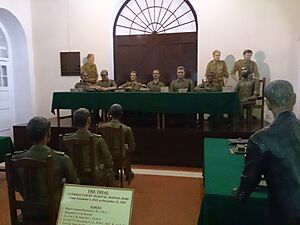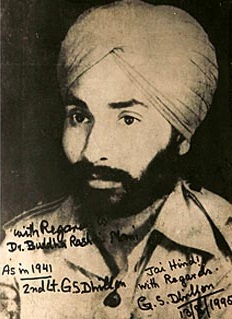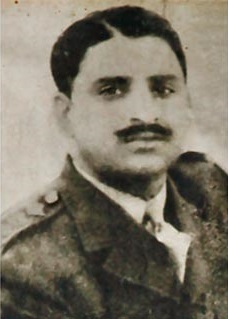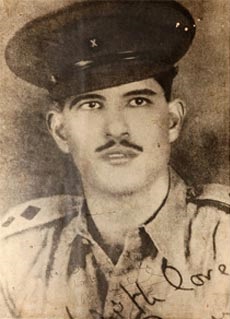Indian National Army trials facts for kids
The Indian National Army trials were important court cases held by the British in India. They took place between November 1945 and May 1946. These trials involved officers from the Indian National Army (INA). The INA was a group of Indian soldiers who fought against British rule during World War II.
The British accused these officers of serious crimes. These included "waging war against the King-Emperor," which meant fighting against the British government. They were also accused of other actions like harming people.
Many important Indian leaders, like Jawaharlal Nehru, helped defend the INA soldiers. The Indian National Congress formed a special committee for their defense. This committee included famous lawyers like Bhulabhai Desai and Tej Bahadur Sapru.
At first, thousands of INA members were going to be tried. But it was hard to prove all the accusations. So, the number of trials was greatly reduced. About ten court cases were held in total.
The first and most famous trial involved three officers: Colonel Prem Sahgal, Colonel Gurbaksh Singh Dhillon, and Major-General Shah Nawaz Khan. These men had been part of the British Indian Army. They were captured during the war in places like Malaya and Singapore. Later, they joined the INA and fought alongside the Japanese army.
Their trial was very public and got a lot of attention. People across India felt great sympathy for the INA soldiers. This was a time when India was close to gaining its independence. The public outcry and growing unrest among British Indian troops eventually led to a big decision. The British Army Chief, Field Marshal Claude Auchinleck, decided to cancel the sentences of the three officers.
Contents
The Indian National Army's Story
The Indian National Army was formed by Indian nationalists living outside India, especially in Southeast Asia. Before World War II, many Indians who wanted independence from British rule found refuge in Japan and other parts of Asia. They believed in fighting for India's freedom.
When World War II began in Southeast Asia, many Indian soldiers were stationed in Malaya. After Japan attacked, about 55,000 Indian soldiers became prisoners of war. Life in Japanese prison camps was very harsh. Some soldiers chose to join a new army when offered freedom by their captors. This new army was the First Indian National Army.
This first INA was led by Mohan Singh Deb. It received support from Japan. However, it was later dissolved due to disagreements about Japan's true intentions.
The Revival of the INA
In June 1943, Subhas Bose arrived and helped restart the INA. He reorganized it as the army of the Arzi Hukumat-e-Azad Hind, also known as the Azad Hind government. This government was formed in October 1943.
The Azad Hind government quickly gained recognition from several countries, including Germany and Japan. It declared war on Britain and America in October 1943. The INA forces fought alongside Japanese troops in places like Imphal and Kohima in 1944. Later, they were involved in the Allied Burma Campaign in 1945.
Most INA troops were captured by British forces during the Burma campaign. By May 1945, the INA had largely stopped fighting. After the war ended, the British government decided to put some of these captured INA soldiers on trial.
Early Trials and Public Attention
Before the famous public trials, some former British Indian Army personnel who fought with the INA were already being tried. These early trials happened quietly and didn't get much public attention. The charges were usually about "waging war against the King."
However, things changed when Sarat Chandra Bose was released in September 1945. The trials then became more organized and public.
The Famous Public Trials
Because so many INA troops were captured, the British decided to select only those accused of the most serious actions for public trials. The first and most important public trial involved Shah Nawaz Khan, Prem Sahgal, and Gurbaksh Singh Dhillon. Other officers like Abdul Rashid and Shinghara Singh were tried later.
The British chose to hold these trials publicly at the Red Fort in Delhi. This was a very important and symbolic location. The trials were complex, so lawyers were allowed to defend the accused. Sir Naushirwan P Engineer was the chief prosecutor for the British.
The INA Defence Committee
The Indian National Congress made the release of the three main defendants a major political goal. They formed the INA Defence Committee in 1945. This committee's job was to defend the INA officers. It also gathered information about captured INA troops and helped them after the war.
The defense team included many prominent leaders and lawyers. Among them were Jawaharlal Nehru, Tej Bahadur Sapru, and Bhulabhai Desai.
The First Big Trial
The first trial of Shah Nawaz Khan, Gurubaksh Singh Dhillon, and Prem Sahgal took place from November to December 1945. It happened during a time of general elections in India.
The three accused officers came from different religious backgrounds – one Hindu, one Sikh, and one Muslim. But they all chose to be defended by the committee set up by the Indian National Congress. They were charged with "waging war against the king." Some also faced accusations of harming or helping to harm others.
The Second Set of Trials
Later trials involved officers like Captain Abdul Rashid, Captain Shinghara Singh Mann, and Captain Malik Munawar Khan Awan.
Captain Shinghara Singh Mann was a brave soldier who received high awards from the Azad Hind government. He was captured by the British and held in prison. After his release, he returned home.
In these later trials, the serious charge of "treason" (fighting against the king) was dropped. This was because of the widespread public anger and support for the INA soldiers. However, these officers were still removed from the army. The trials were also moved from the Red Fort to a nearby building.
What Happened After the Trials
The INA trials caused a huge wave of protests and support across India. People from different groups, including the Congress and the Muslim League, came together to protest. They flew both the Indian national flag and the Muslim League's green flag side by side.
Despite the strong public opposition, the court-martial went ahead. The three main defendants were sentenced to be sent away for life. However, this sentence was never carried out. The enormous public pressure forced Claude Auchinleck, the Commander-in-Chief of the Indian Army, to release all three officers. A popular slogan at the time was, "Laal quile se aayi aawaz, Sahgal, Dhillon, Shahnawaaz" (From the Red Fort came the voice, Sahgal, Dhillon, Shahnawaz).
The trials also led to other important events. A mutiny (rebellion) broke out in the Royal Indian Navy. This involved ships and naval bases across India. What worried the British most was the strong public support for the mutineers. In some places, British Indian Army soldiers even started ignoring orders from their British officers.
Another army mutiny happened in Jabalpur in February 1946. It lasted about a week and was also put down. Many soldiers were tried and punished.
Most INA soldiers were eventually set free. However, they lost their pay and were removed from the army.
After the war, Lord Louis Mountbatten, a British commander, ordered the demolition of an INA memorial in Singapore. Some historians believe this was to prevent the spread of the INA's ideas during the Cold War and the time of decolonization. However, in 1995, the site was recognized as a historical place, and a new memorial was built there.
The story of the INA and their trials was so powerful that the British government tried to keep it quiet. They even forbade the BBC from broadcasting their story. But news of the trials at the Red Fort still spread. Reports that some INA soldiers had been executed only led to more protests.
See also
- Indian National Army
- INA Defence Committee, the legal team that defended the INA soldiers.
- Shah Nawaz Khan, Gurbaksh Singh Dhillon and Prem Kumar Sahgal, the main defendants in the first INA trial.
- Malik Munawar Khan Awan, an INA commander.
- Habib-ur-Rehman, Subhas Chandra Bose's chief of staff.
- Lakshmi Sahgal, who led the Rani of Jhansi Regiment, a women's unit in the INA.
- Indian National Congress





